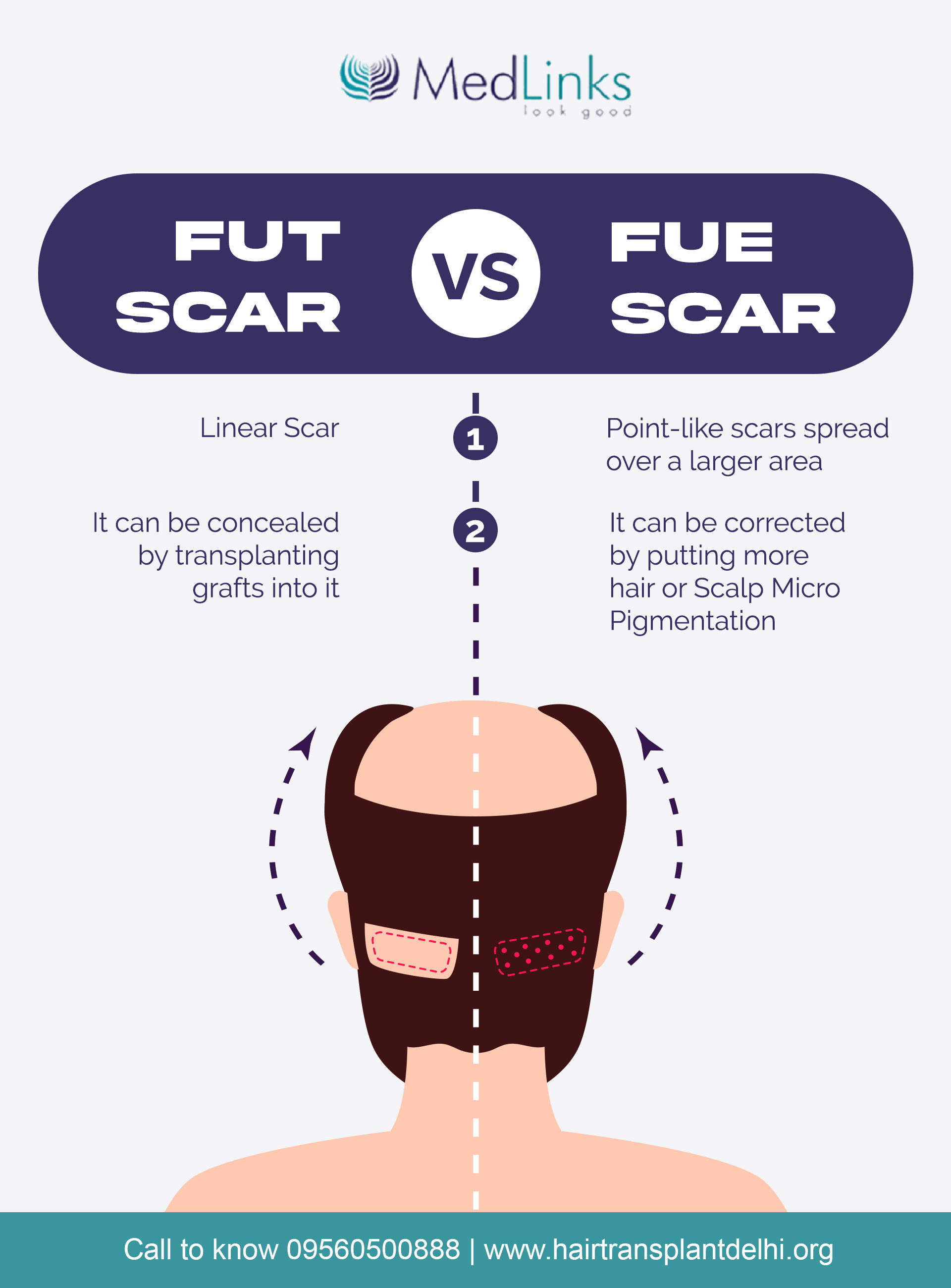- Home
- About Us
- Hair Transplant
- Hair Loss
- Medical Treatment
- Patients Gallery
- Our Patients
- Blog
- Contact Us
- Hair Transplant Cost
- Book an Appointment
- Brochure

When you plan to undergo a hair transplant to restore hair growth and elevate your confidence, the one lingering question is, “Will it leave behind a permanent scar?” Despite hair transplants coming a long way with advanced medical procedures, scarring is a consequence every patient has to deal with. Some of the best hair transplants in India can leave minimal scarring, while a few will leave a larger (and more visible) one.
Hair Transplant Surgeons worldwide use two primary types of hair transplant procedures – the Follicular Unit Extraction (FUE) or the Follicular Unit Transplantation (FUT). Both types produce a different form of scarring on the donor site (primarily the back of the scalp). Choosing the best surgeon for the procedure will determine the degree of scarring you may have after the treatment.
Here, we will be discussing everything one should know about hair transplant scars and how you can get rid of them eventually.
Feel free to skip ahead if one topic catches your eye:
A hair transplant is a type of cosmetic treatment done to restore hair growth and cover bald patches on the scalp. The surgeon generally moves the viable and potent hair follicles from the donor site (mainly the back of the scalp) to the recipient site (where the bald patches or thinning is).
The procedure is generally done under local anaesthesia.
Coming to the best hair transplant treatment in India, there are predominantly two types that we should be aware of. They include:
Depending on which type of hair transplantation you undergo, the procedure will be different. However, the preparation for the surgery starts with the Hair Transplant Surgeon cleaning the scalp (both the donor and recipient site), followed by the anesthesia or numbing cream.
Medlinks has their patent Perfect-i type of hair transplantation, which is the top transplant procedure in India. This ultra-modern and refined type of hair transplantation is practiced by leading Hair Transplant Surgeons at Medlinks to offer patients better satisfaction.
Perfect-i uses the feather touch technique of implantation, wherein the graft is held from the tip of the dead hair during implantation. This improves the viability of the follicles and ensures better results in the end.
As mentioned in detail in the previous section, hair transplant involves making incisions or micro-puncturing procedures for extraction and implantation of the grafts. This eventually leaves a scar on the donor and the recipient site, both of which heal over time.
The degree of visibility of the scarring will depend on the efficiency of the surgeon. If you pay the hair transplant cost in India and get the procedure done by an unskilled surgeon, it will leave you with severe and permanent scarring.
On the contrary, getting the procedure done by a qualified and professionally experienced surgeon will ensure minimal scarring with proper aftercare.
The level of scarring after a month or two of the surgery is also dependent on how well you have taken care of the scar and followed the aftercare instructions like they were advised to you.
Unfortunately, yes.
A hair transplant scar is permanent. However, the nature of visibility of the scar is different for every patient.
Some scars fade over time with proper care and the right products and treatment, while most of the other ones are hidden underneath your hair. However, the key to “minimal scarring” on the scalp is choosing the best hair transplant clinic in India. If your surgeon is qualified and skilled, you wouldn’t have to worry about “visible” scarring.
Indeed, you shouldn’t worry about the hair transplant scar on your head at all, especially if you are young. It is only when you are older with possibly sagging skin that your scar MIGHT become visible again. But, that is a worry that you need to leave out with your future self. All you need to do is enjoy the results, live the prime time of your life to the fullest with the confidence that you can muster.
Both (or in this case three) types of hair transplant procedures carry risks of scarring. Some less, some more.
The type of scar tissue that you develop on your scalp depends on the type of hair transplant procedure you are undergoing. Here’s what we know about these individual ones:
During a FUT hair transplant, a section of skin with the hair follicles is extracted from the back of the scalp. This leaves a long and pale horizontal FUT scar on the incision site that might seem daunting for the first few months after the treatment. However, it does get fully covered with the patient’s hair eventually once the surrounding hair grows longer.
You’d be surprised to know, but despite being a minimally invasive procedure, the FUE scars are more as compared to FUT scars. However, despite more scarring with the small round scars, they are spread out over a larger expanse of the scalp, making them less visible. The patients can even keep their hair short over time if they want without worrying about the scars being visible.
Despite the procedure, both FUT and FUE scars fade over time, leaving minimal visibility so you wouldn’t have to worry about any future consequences.

At Medlinks, the FUT and FUE hair transplantation procedures are done by a leading hair transplant surgeon in India, Dr. Gaurang Krishna, who is known for his experience in this field. His professional approach with the refined techniques ensures minimal scarring and maximal results and satisfaction in the patients.
Managing hair transplant scarring is dependent on several factors. You need to initially get the best hair transplant in India and follow the aftercare instructions. Most of the time, the lack of aftercare leads to more prominent scarring on the scalp.
If your surgeon has advised you to apply a topical healing ointment, apply it without fail. If your surgeon has asked you to complete a course of antibiotics and anti-inflammatories, then complete it. These small aftercare tips will impact the healing of the scars and decide their visibility in the long run.
Aside from that, you can follow these quick hacks to conceal and manage the scar tissues:
When it comes to managing the scars and their visibility, there are viable options for hair transplant scar treatment in Delhi. This helps minimize the visibility of the scar tissue to prevent future complications and regrets.
However, the scar treatments should be done after the complete healing of the follicles and the incisions on the scalp after the hair transplant surgery. Waiting till complete healing also gives you an idea about the extent of the scarring and whether it needs additional treatment or not.
Following are few of the treatment options that you can consider:
Scar correction surgery – this is primarily done in patients who have undergone hair transplant surgeries from untrained professionals. Scar correction surgery minimizes the extent of the visibility of the scar tissue. In this procedure, the excess scar tissue is removed off the skin and then adjoining skin is stretched and stitched together with a more refined and natural finish.
Micro-pigmentation methods – mimicking the process of a 3D tattoo, in this procedure, the doctors use permanent ink to create a gradient around the scar tissue to make it blend with the skin around. The scar then blends with the natural hair on your scalp and doesn’t stand out as a prominent scar.
Laser treatment – it is often used in conjunction with scar correction and micro-pigmentation methods for more accurate results. The laser reduces the appearance of the scars and improves collagen production on the skin’s dermal layer to enhance skin elasticity.
The results of a successful hair transplant make you realize the fact that some scars are worth it. However, that doesn’t mean that you need to bear the burden of it throughout your life.
If you are troubled with a visible scar after hair transplant surgery, Medlinks is the right place to be in. Not only surgeons can guide you throughout the procedure, but you can undergo scar removal treatments also if needed.
However, we’d always recommend undergoing your initial hair transplant surgery from Medlinks itself to cut down any risks of visible scarring. Not only are you going to stay under the care of a renowned surgeon and equipped team, but the center is also known for using refined treatment methods that involve minimal scarring.
Take Perfect-i, for example. The procedure is a patented venture under Medlinks and has revolutionized hair transplant surgery in India. It is prompt, more effective, and inflicts minimal scarring on the recipient and donor site.
Scarring is an inevitable consequence of hair transplant surgery. Some patients have minimal scarring that heals over time and some patients have very visible scarring. Whatever the results are, keep in mind that the scarring level depends on the choice you make.
Choosing an experienced, qualified, and professional Hair Transplant Surgeon is key to satisfying results. So, make an informed decision. At Medlinks, surgeons use cutting-edge technology for the highest satisfaction and promising results for every patient.

Dr. Gaurang Krishna

Copyright © 2025 Medlinks. All Rights Reserved.
Disclaimer:The content published on this website(hairtransplantdelhi.org) is meant to spread awareness and educate the concerned patients regarding baldness and hair transplants as well as the treatment options available for baldness and hair transplant treatment in Delhi India. Any information on the website shall not be regarded as a prescription from a professional dermatologist. We recommend visiting a dermatologist in person for the right diagnosis and the treatment for any hair issues. We do not guarantee specific results as the treatments and the results vary from person to person.